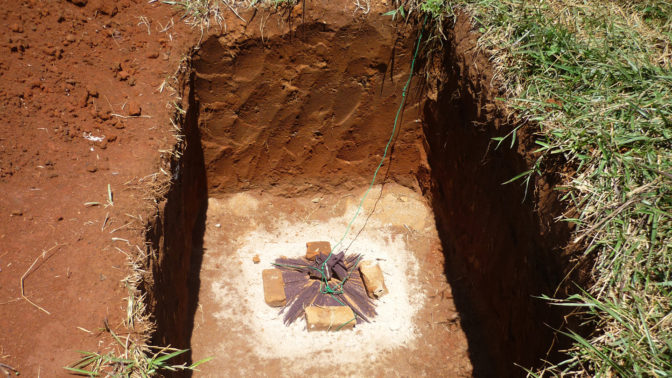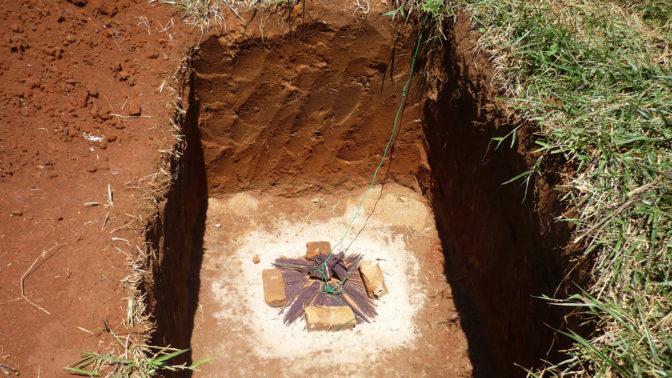SHIPO Tube Recharge
Tube Recharge redirects rainwater into the ground to increase well capacity.
Key Facts
- When it rains, water flows into the pit via a cloth, sand filter, and PVC tube and is “injected” into the ground.
- Part of the water will stay around the well increasing well capacity.
- Tube Recharge can be produced with local materials.
- A 1-2 day training is needed to learn how to make a Tube Recharge.
- It is a very, if not the most, cost-effective option to store rainwater.

Key Features
A Tube Recharge redirects rainwater into the ground near wells so that wells don’t dry up. It is used where compact soils cause rain to flow away. It consists of a round pit of 0.7 meters deep. The diameter depends on the rain pattern; few rains require large diameters. Inside the pit is a small injection hole is made with an auger in soft layers, or a stone punch in hard layers. The depth of this hole is 3-8 meters to pass the top compact (clay) layer. It should not enter directly in the aquifer.
When it rains, water flows into the pit and via a cloth, sand filter, and PVC tube and is “injected” into the ground. Water will saturate the soil and trickle down into the aquifer; 1 to 10 cubic meters can be recharged in the ground each time it rains. Part of the water will stay around the well increasing well capacity. Tools needed to make a Tube Recharge can be produced with local materials. A 1-2 day training is needed to learn how to make a Tube Recharge. Follow up control is needed to guarantee good quality.
Unique benefits:
- It is a very, if not the most, cost-effective option to store rainwater.
- Each year, 100–500 cubic meters of rain water can be stored at a cost of labor and USD $10-20 for materials.
- It stores rainwater that otherwise would flow away to rivers and be lost.
- It can avoid wells from drying up at the end of the dry season.
- After training, families themselves can make a Tube Recharge.
Social Impact
The Tube Recharge was developed to increase the number of affordable options for storing rainwater.
With climate change, it is increasingly important to store water in the rainy season so it can be used in the dry season. Many of the 3-5 million hand dug wells in Africa dry up at the end of the dry season for reasons like limited water content in the upper aquifer, over-extraction, or lack of rainwater infiltration due to effects of climate change. (Knoop et al. 2012).
Options to increase infiltration of rainwater include spate irrigation, sand dams, cultivation on contour, or planting trees and plants like vetiver. The Tube Recharge is one of the 3R technologies mentioned in the publication, “Securing water and land in the Tana basin” (Knoop. 2012). (3R stands for Recharge, Retention, Reuse). The principle is based on recharge pits as used in India but it includes an injection hole and a sand filter to avoid clogging of the system.
How does it improve the lives of users?
Families and communities who install this recharge system benefit since they may avoid that their well dries up. Also it can increase the volume of water that can be extracted from a well so water can be used for production like life stock or garden irrigation, etc.
Future Plans
The SHIPO SMART Centre will further demonstrate and promote this technology in Tanzania.
Also SMART Centres in Zambia. Malawi, Mozambique and other countries will further promote this technology.
Main Target Group
The Tube Recharge is not so much a product but a technology that can be applied after training.
Target groups of this training are organizations and governments interested in rainwater harvesting, groundwater recharge, water storage, improving livelihoods, household water supply, or rural water supply.
Main User
Families in peri-urban and rural areas who have wells that dry up or who want to increase the capacity of their wells.
Price (in USD)
The cost of a Tube Recharge is $10-20 for materials and the cost of training potential users for 1 to 2 days.
The cost of the tools needed to make the injection hole of a Tube Recharge range from $50-150.



